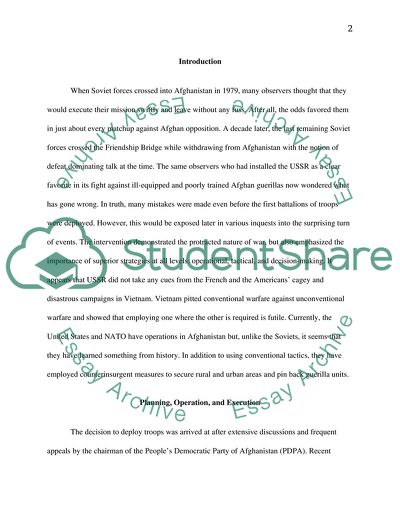Cite this document
(Analysis of the Soviet Intervention in Afghanistan Coursework Example | Topics and Well Written Essays - 4000 words - 5, n.d.)
Analysis of the Soviet Intervention in Afghanistan Coursework Example | Topics and Well Written Essays - 4000 words - 5. https://studentshare.org/military/1861296-analyse-at-the-operational-level-the-planning-and-prosecution-of-the-campaigns-waged-by-the-principle-participants-in-the-soviet-intervention-in-afghanistan-and-identify-any-relevant-lessons-for-contemporary-commanders
Analysis of the Soviet Intervention in Afghanistan Coursework Example | Topics and Well Written Essays - 4000 words - 5. https://studentshare.org/military/1861296-analyse-at-the-operational-level-the-planning-and-prosecution-of-the-campaigns-waged-by-the-principle-participants-in-the-soviet-intervention-in-afghanistan-and-identify-any-relevant-lessons-for-contemporary-commanders
(Analysis of the Soviet Intervention in Afghanistan Coursework Example | Topics and Well Written Essays - 4000 Words - 5)
Analysis of the Soviet Intervention in Afghanistan Coursework Example | Topics and Well Written Essays - 4000 Words - 5. https://studentshare.org/military/1861296-analyse-at-the-operational-level-the-planning-and-prosecution-of-the-campaigns-waged-by-the-principle-participants-in-the-soviet-intervention-in-afghanistan-and-identify-any-relevant-lessons-for-contemporary-commanders.
Analysis of the Soviet Intervention in Afghanistan Coursework Example | Topics and Well Written Essays - 4000 Words - 5. https://studentshare.org/military/1861296-analyse-at-the-operational-level-the-planning-and-prosecution-of-the-campaigns-waged-by-the-principle-participants-in-the-soviet-intervention-in-afghanistan-and-identify-any-relevant-lessons-for-contemporary-commanders.
“Analysis of the Soviet Intervention in Afghanistan Coursework Example | Topics and Well Written Essays - 4000 Words - 5”. https://studentshare.org/military/1861296-analyse-at-the-operational-level-the-planning-and-prosecution-of-the-campaigns-waged-by-the-principle-participants-in-the-soviet-intervention-in-afghanistan-and-identify-any-relevant-lessons-for-contemporary-commanders.


